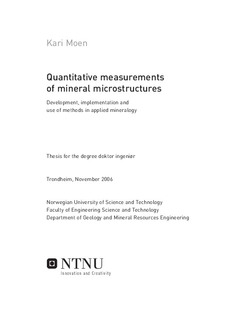| dc.contributor.author | Moen, Kari | nb_NO |
| dc.date.accessioned | 2014-12-19T11:53:49Z | |
| dc.date.available | 2014-12-19T11:53:49Z | |
| dc.date.created | 2008-01-24 | nb_NO |
| dc.date.issued | 2006 | nb_NO |
| dc.identifier | 123341 | nb_NO |
| dc.identifier.isbn | 82-471-8162-2 | nb_NO |
| dc.identifier.uri | http://hdl.handle.net/11250/235833 | |
| dc.description.abstract | The project has been in applied mineralogy. Advanced characterisation techniques have been developed and used as a tool for quantitatively describing geological raw materials, middlings and end products for optimal exploitation of mineralogical materials. The overall purpose has been to develop skills and techniques on detection and quantification of mineralogy and microstructures by means of various scanning electron microscopy (SEM) techniques. A premise for success was then to develop a close cooperation with the staff at the electron microscopy laboratory at Department of Materials Science and Engineering at the initiation of the project. A specific objective has been to develop and implement automatic SEM-based quantitative measurements on major and trace minerals in rocks, ores and milled products in order to measure modal mineralogy, microstructures and particle texture including mineral liberation and mineral association. Through collaboration with engineers and researchers in different aspects of mineral production, the work has included development of software, implementation and testing of software, and case studies for the industry and other collaborators. Five papers are included in the thesis. Papers 1 and 2 present methods for quantitative measurements of minerals covering the principles of PTA and EBSD analysis and some case studies. Papers 3-5 present microstructure studies of marble and deeply buried sandstone. In addition, Chapter 5 treats the development of the PTA more thoroughly. The main conclusions from the study are:
A method for detailed, quantitative measurements of main and trace minerals and particle texture has been developed in close relation with the industry. The data acquisition is based on commercial hard- and software and the results are post-processed in the developed PTA software. In the future, the PTA will be further developed and it is a goal to launch the system on the commercial market.
Several cases of raw material, middlings and end products from the mineral industry were investigated by means of PTA analysis throughout the doctoral study. Modal mineralogy, mineral liberation, mineral associations and mineral intergrowths and the contribution from various minerals to certain elements, have been studied. The cases have demonstrated the strength and the possibilities of the programme.
Electron backscatter diffraction was tested and evaluated as a relatively new approach in applied mineralogy, characterising the crystallography. EBSD is not found suitable for ordinary particle analysis, but the technique is superior when studying polymorphs, and in quantitative measurements of lattice orientation and fabric parameters obtained from the measurements of crystal orientations. The microstructure of marble used for exterior cladding panels were investigated with respect to deterioration. Several aspects of the microstructure were measured and analysed, and a prediction model for bowing of marble slabs was calculated. For direction dependent bowing, the grain shape orientation (foliations, lineation) was regarded as most important together with lattice preferred orientation because of extremely anisotropic thermal behaviour of calcite. The variables that influenced the intensity of bowing in the prediction model were grain shape or roughness of the grain boundaries and the shape of the grain-size distribution curve.
Optical and electron microscopy techniques were used to investigate relations of diagenesis and microstructure in quartz grains and quartz cement in reservoir sandstones from offshore Norway to search for possible evidences of compaction induced deformation. The quartz overgrowths were indistinguishable from the host grain in EBSD maps supporting syntaxial growth. From low-angle boundary studies it was concluded that cement growth was not accompanied by recrystallisation. Dauphiné twins were common both in cemented and non-cemented samples and it was suggested that some of the twins at quartz grain edges and quartz cement-grain contacts may be related to burial compaction. This implies a mechanism of grain-boundary deformation in burial diagenesis, which is invisible using conventional petrographic tools. During the development and implementation of systems and techniques, competence has been developed in the intersection between geology and materials technology. The research groups have become integrated with a common instrument laboratory and knowledge to further develop the laboratory as a resource in applied mineralogical research. | nb_NO |
| dc.language | eng | nb_NO |
| dc.publisher | Fakultet for ingeniørvitenskap og teknologi | nb_NO |
| dc.relation.ispartofseries | Doktoravhandlinger ved NTNU, 1503-8181; 2006:194 | nb_NO |
| dc.relation.haspart | Moen, K; Malvik, T; Breivik, T; Hjelen, J. Particle Texture Analysis in Process Mineralogy. XXIII International Mineral Processing Congress, 3-8 September 2006, Istanbul, 2006. | nb_NO |
| dc.relation.haspart | Moen, Kari; Malvik, T; Hjelen, J; Leinum, J. R. EBSD – A potential supplementary technique in quantitative characterisation of minerals. XXII IMPC, SAIMM, Cape Town, 2003. | nb_NO |
| dc.relation.haspart | Moen, K; Malvik, T; Hjelen, J; Leinum, J. R; Alfnæs, L. EBSD Microstructure Measurements of Marble. Applied Mineralogy - 2004 ICAM-BR, São Paulo, 2004. | nb_NO |
| dc.relation.haspart | Moen, K; Malvik, T; Alfnæs, L; Hjelen, J. Quantitative measurements of marble microstructure -a model for predicting the deterioration of marble. Environmental Geology, 2006. | nb_NO |
| dc.relation.haspart | Mørk, M. B; Moen, K. Reconnaissance study of compaction microstructures in quartz grains and quartz cement in deeply buried sandstones using combined petrography - EBSD analysis. . | nb_NO |
| dc.title | Quantitative Measurements of Mineral Microstructures: Development, implementation and use of methods in applied mineralogy | nb_NO |
| dc.type | Doctoral thesis | nb_NO |
| dc.contributor.department | Norges teknisk-naturvitenskapelige universitet, Fakultet for ingeniørvitenskap og teknologi, Institutt for geologi og bergteknikk | nb_NO |
| dc.description.degree | dr.ing. | nb_NO |
| dc.description.degree | dr.ing. | en_GB |
